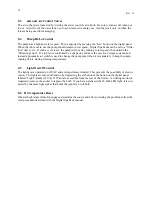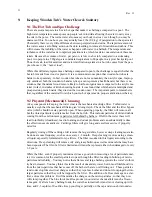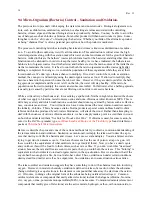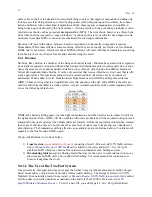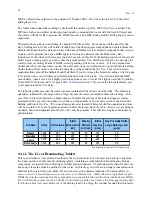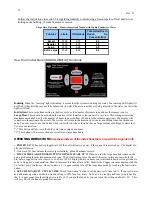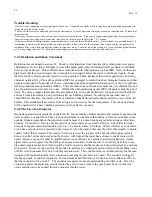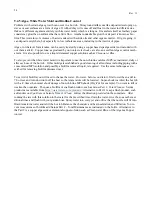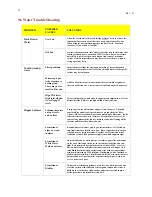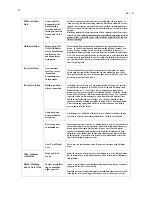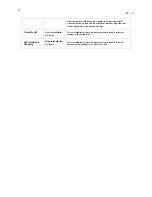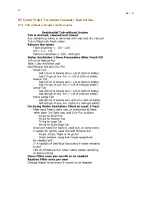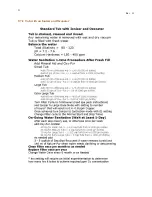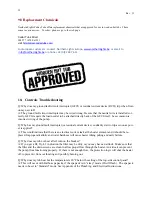
18
Rev 13
MPS, a chlorine free oxidizer) in the amount of 125 gms/1000 l
.
Do not use the tub for 12 hours after
adding these two.
The NaBr, when added does nothing by itself until the oxidizer (part 2), MPS (
Oxy-Pur
), is added. The
MPS acts both as an oxidizer destroying dead organic compounds that came with the fresh fill water and
also reacts with the NaBr to produce the HOBr (sanitizer) and OBr
-
(weak oxidizer) killing any live micro-
organisms.
Thereafter, the regime is to add 30mg (1 capful)/1000 litres of
Oxy-Pur
at the end of the day after the
day’s bathing session. This will oxidize (break-down) the dead organic compounds and containments the
bathers introduced into the water and react with unused NaBr as well as bromide compounds that wer pre-
viously used to produce the active HOBr again to destroy any bacteria that the bathers may have
introduced. If the tub hasn’t been used, you don’t need to do this. Or, if the bathing session was short and
didn’t involve many people, you can reduce the amount added. You will discover that by the next day the
water is clear yet mostly absent of HOBr (test strip reading will be low or zero). If it is a personal resi-
dential use tub do not fuss when you test the water and you get no indication on your strips before bathing.
Do the testing after you have used the tub and after you have added the
Oxy-Pur
. This is when micro-
organisms that came off the bathers should be killed. If you try to keep the bromine reading at the 2-4 ppm
level all the time, you will likely over-brominate and end up with a rash. You will replenish the NaBr
occasionally (once a week for a highly used tub and once every 2 weeks for a lightly used tub) by adding
30 ml/1000 l of
Mineral-Aid
(
or12 gms/1000 l of
Bromine-Booster
)
. If you use the tub sporadically, you
won’t need to add
Oxy-Pur
daily.
The following table provides the water volumes contained in the various sized hot tubs. The chemicals
quantities, indicated for the larger tubs is large, because the water contained in these tubs is large. How-
ever if the tub is not subjected to a high number of bathers the amount of bacteria and organic wastes
produced will be at a lower end and you will have to experiment by how much you can reduce the after-
bathing addition of
Oxy-Pur
. If you use
Bromine-Booster
instead of
Mineral-Aid
the quantities in grams
will be in a ratio of 2.5 less in grams as shown in ml for
Mineral-Aid
in the table. Also, if you are using an
ozonator, downward adjustments of the
Oxy-Pur
may be possible. This will also require some initial ex-
perimentation.
Small
1334
351
167
40
167
Regular
1819
479
227
55
227
Large
2378
626
297
71
297
Extra Large
3124
822
391
94
391
Oxy-Pur Added After
Large Bathing Load
(gms)
US Gallons
Tub Size
Liters
Weekly
Mineral
Aid (ml)
Initial
Mineral Aid
(ml)
Initial
Oxy-Pur
(gms)
40
55
71
94
See Note below to measure Oxy-Pur without a scale
9.4.1.2 The Use of Brominating Tablets
This is an alternative, less preferred method to the 2-part method. It can be used as a backup to augment
the 2-part method. In this case brominating tablets, containing a combination of bromine and chlorine
compounds, are inserted into a floating or in-filter feeder dispenser. The tablets slowly dissolve and con-
tinuously release the bromine sanitizer to the water. In this case you will have a stronger concentration of
sanitizer in the water when you bathe. Be aware however the chemical makeup of bromine tablets is
1-
bromo-3-chloro-5, 5-dimethylhydantoin
and thus this is not
chlorine free. While the active ingredient is again
HOBr the chlorine component in the compound acts to regenerate the used bromine ions back into HOBr,
but it will also have some reaction with the wood (turning it pulpy over time), albeit less aggressively that
if chlorine tables were used.
However, if the bathing load is too large, the residual bromine that this meth-







